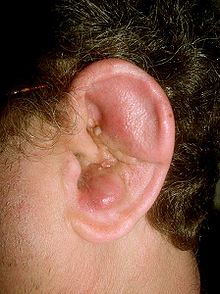Perichondritis
| Classification according to ICD-10 | |
|---|---|
| H61.0 | Perichondritis of the outer ear |
| ICD-10 online (WHO version 2019) | |
As Perichondritis inflammation is perichondrium referred. By far the most common form is auricular perichondritis , which is discussed in this article. However, cartilage inflammation can also occur on the larynx or the nose.
causes
The main cause of auricular perichondritis is the penetration of germs into the skin, usually via micro-injuries. Even after surgical interventions on the auricle , auricle piercing or injuries with an othematoma , cartilage inflammation can occur. The most common pathogens are Pseudomonas and Staphylococci . Mycobacterial infections have also been described.
Symptoms
Characteristic signs of the disease are reddening and painful swelling of the auricle. Typically, the earlobe is spared from the inflammation because it does not contain any cartilage. This is an important differential diagnostic indicator to distinguish it from the erysipelas , which is also not infrequently located on the auricle , in which the inflammation also spreads to the earlobe and the skin adjacent to the auricle. In the advanced stage of perichondritis, the inflammation spreads to the cartilage and necrosis occurs with changes in the shape of the ear cartilage as a long-term consequence ( cauliflower ear ).
therapy
At the onset of the disease, antibiotics are given in tablet form. The first choice products are ciprofloxacin and levofloxacin . At an advanced stage, antibiotics are sometimes required and can only be given as an infusion.
In the stage of necrosis, surgical interventions with removal of the decayed ear cartilage may be necessary in order to limit the destruction of the auricle. Rinses with z. B. Rivanol are helpful as a supportive measure, but by no means sufficient as a sole measure.
Perichondritis as part of a systemic disease
In 1923 the Austrian internist Rudolf von Jaksch first described a febrile, inflammatory multi-system disease involving the nasal, ear and joint cartilage ( arthritis ). The very rare clinical picture was also referred to as recurrent polychondritis or Meyenburg-Altherr-Uehlinger syndrome in the following years and is now classified as autoimmune diseases .
Individual evidence
- ↑ Hanif et al .: Lesson of the week: "High" ear piercing and the rising incidence of perichondritis of the pinna. In: BMJ. 2001; 322, pp. 906-907. PMID 11302908 full text
- ↑ a b Expert commission of the Infectious League of the Baden-Württemberg Medical Association 2005
- ^ KA Horii, MA Jackson: Images in clinical medicine. Piercing-related nontuberculous mycobacterial infection . In: N. Engl. J. Med. Band 362 , no. 21 , May 2010, p. 2012 , doi : 10.1056 / NEJMicm0906854 , PMID 20505180 .
- ↑ Braun-Falco et al: Dermatology and Venereology. 5th edition. Springer-Verlag, 2005, p. 1005f.

